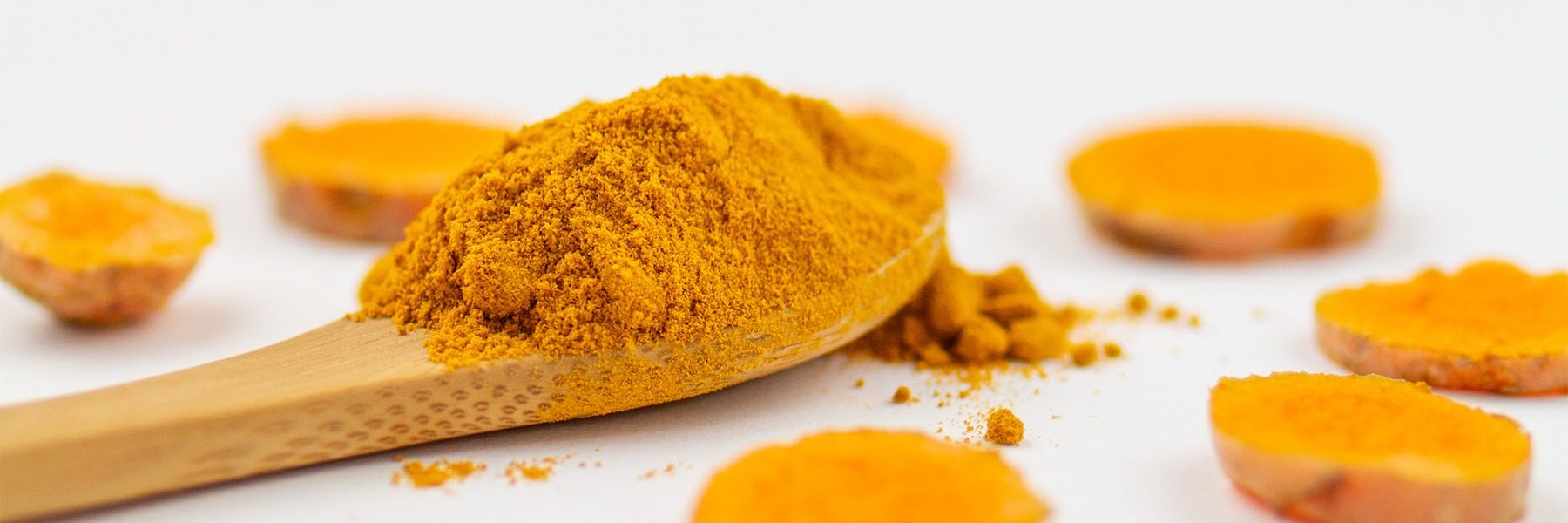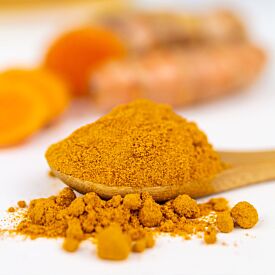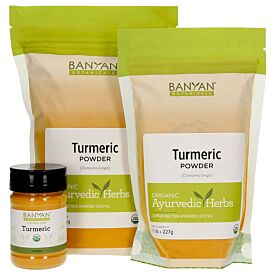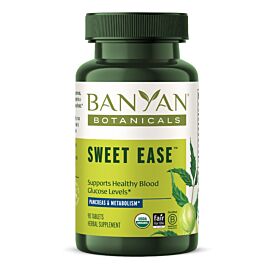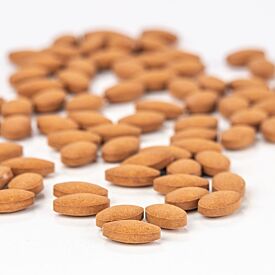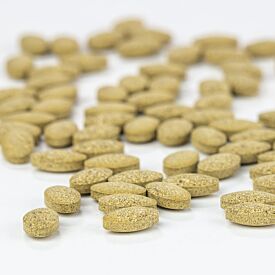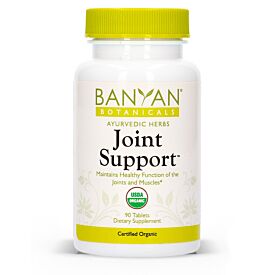The Benefits of Turmeric
Turmeric, or Curcuma longa, is one of the most well-known, widely researched, and commonly used Ayurvedic spices in the world. This golden wonder is used in cooking, as a dietary supplement with numerous health benefits, and even topically for beauty treatments.
No curry is complete without the unique and delicious flavor of turmeric, and there’s hardly a system in the body that isn’t supported by the healing benefits of this powerful root. And every traditional Indian bride is layered in turmeric paste before her wedding to create a special glow.
In this article:
- Characteristics of the Turmeric Plant
- Turmeric Uses and Benefits
- Modern Research on Turmeric
- How to Take Turmeric
- Is Turmeric Safe?
- Growing and Harvesting Banyan’s Turmeric
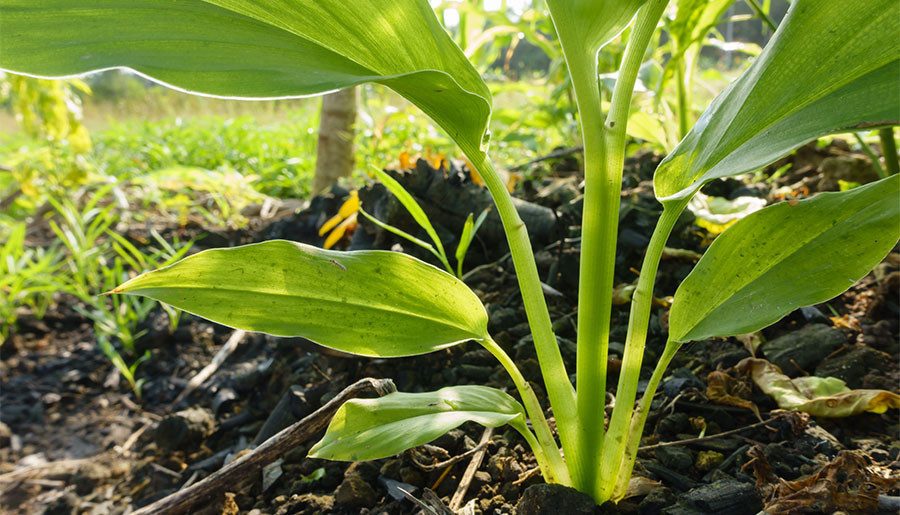
Characteristics of the Turmeric Plant
Turmeric is well known for its vibrant golden color and unique bulbous shape. A member of the rhizomatous ginger family Zingiberaceae, Curcuma longa is a perennial plant native to tropical South Asia.1 Turmeric thrives in warm climates and requires a considerable amount of annual rainfall to flourish.
Individual plants grow to a height of 3–4 feet and have long, oblong leaves. These plants are gathered annually for their tuberous rhizomes, which can be eaten fresh or dried and ground into a bright golden powder.
As many as 133 species of Curcuma have been identified worldwide, many of which have common local names and have been used throughout time for their beneficial properties.2
In Northern India, turmeric is sometimes called by its Sanskrit name haridra, and in other parts of the country it is referred to as “Indian saffron” because of its brilliant yellow color. The Latin root of turmeric is terre merita, or meritorious earth, in homage to its mineral-colored ochre hue. And in many places, turmeric is simply referred to as “yellow root.”3
Is Turmeric an Herb?
If you're familiar with the orange-tinted, rough-skinned bulbs of turmeric found at the grocery store, their unique shape and form may lead you to wonder, where does turmeric come from? Is it a root? Is it a vegetable? Is it even an herb at all?
Though it is often assumed to be a root, turmeric is actually a rhizome, or underground stem, of the Curcuma longa plant. Ginger is another example of a well-known rhizome. Both of these plants carry powerful health benefits and are indeed considered herbs, having been used throughout history to address a variety of ailments and support well-being.
Turmeric Uses and Benefits
The vibrant golden root of the turmeric plant has been used for centuries throughout Asia to support health throughout the entire body. It has a particular affinity for the blood,4 and is thereby able to circulate its powerful health benefits to a number of systems and functions throughout the body. Turmeric is known to:
- Promote healthy digestion: Turmeric works to improve intestinal flora, strengthen digestion and metabolism, and aids in the breakdown of proteins.5
- Boost the brain and nervous system: Turmeric has been shown to regenerate and protect the cells of the nervous system, relieving anxiousness, uplifting mood, and improving brain health.6
- Support comfortable joint movement: It can be taken internally or applied externally to strengthen and fortify the joints, tendons, and ligaments, leading to greater joint comfort and easeful movement.7
- Promote clear, glowing skin: Considered a tonic for the skin and blood, turmeric helps to cleanse impurities and support a clear complexion.8
- Support proper function of the liver: When used regularly, turmeric promotes the healthy function of the liver and supports the body’s natural mechanisms of detoxification.9
- Nourish the heart and circulatory system: It helps to warm and stimulate the growth of new blood tissue, aiding healthy function of the heart and strengthening circulation.10
- Bolster the immune system: As a potent source of antioxidants, turmeric helps to strengthen the immune system, protect the body from free radicals, and ward off imbalance.11
Turmeric and Ayurveda
Turmeric is used in Ayurveda to balance all three doshas—vata, pitta, and kapha. If taken in excess however, it can aggravate pitta and vata. Turmeric has a bitter taste (rasa), an astringent energetic effect (virya), and its post-digestive effect (vipaka) is pungent and heating.12
Turmeric has a particularly beneficial effect for rasa dhatu and rakta dhatu, the tissues of the blood, plasma, and lymph. It brings a soothing and cooling quality to these tissues while at the same time enlivening their healthy flow and function.
Turmeric’s heating nature enables it to have a mobilizing and cleansing energy, which naturally kindles agni (digestion), helping to reduce excess kapha and any accumulation of ama (toxicity).
Beyond these systems, turmeric is also traditionally used for supporting the liver, muscles and joints, immune system, and skin.13
In India, turmeric is said to give the energy of the Divine Mother and to grant prosperity.14 It is often used as a topical paste by brides to give a radiant glow and invite blessings into the marriage. Whole turmeric root is also sometimes used to carve a likeness of Ganesha, the elephant-headed god of prosperity and success, as a way of invoking the strength to overcome obstacles.
Turmeric is also popular in yogic traditions, where it is used to support the ligaments and cleanse the nadis and chakras, the subtle channels and energetic centers of the body.15
Modern Research on Turmeric
With its ever-growing renown, turmeric has become the focus of many studies throughout the years and has been widely researched for its extraordinary benefits. Here are a few prominent studies on turmeric from the past decade:
- “Neuroprotective Expression of Turmeric and Curcumin.” Food Research. Dec 2020.16
- “Turmeric and Its Major Compound Curcumin on Health: Bioactive Effects and Safety Profiles for Food, Pharmaceutical, Biotechnological and Medicinal Applications.” PubMed Abstract. Sep 2020.17
- “Curcumin Intervention for Cognitive Function in Different Types of People: A Systematic Review and Meta-analysis.” PubMed Abstract. Sep 2019.18
- “Curcumin: A Review of Its Effects on Human Health.” PubMed Abstract. Oct 2017.19
- “Therapeutic Roles of Curcumin: Lessons Learned from Clinical Trials.” PubMed Abstract. Jan 2013.20
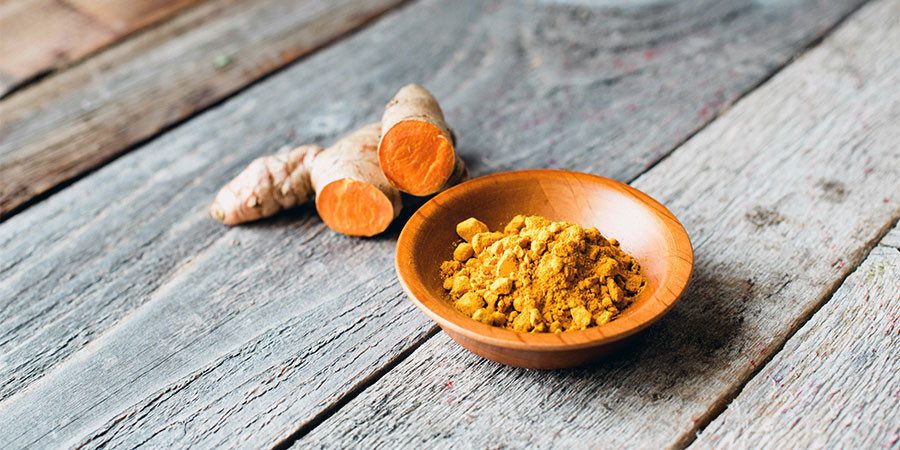
Curcumin Extract vs. Whole Turmeric Root
Of special interest when it comes to modern research on turmeric is whether it’s best to take turmeric in its whole herb form, or a supplement that consists solely of the active ingredient, curcumin, extracted from the whole herb.
For centuries, traditional systems like Ayurveda have used turmeric, both fresh and as a dried spice powder, to promote health. In recent years, researchers have promoted the idea that the active ingredient that provides benefit is curcumin.
Studies require that everything is quantifiable, so that if the results are beneficial, people can be told exactly how much to take. Standardized extracts provide this convenience, as you know exactly how much curcumin you are getting, and the studies can be done at “higher doses.”
What has been discovered, however, is that curcumin has a low bioavailability—meaning it gets excreted or metabolized by the body before the active curcumin can reach the blood stream and other organs. This means that just because your supplement has curcumin extract doesn’t mean that your body will be able to get the benefits.
These findings began a search for other substances that could help increase the bioavailability of curcumin. In 1998, there was a study that showed piperine, the active ingredient of black pepper (Piper nigrum), paired with the curcumin helped increase the levels of curcumin in the blood.21
So people started formulating curcumin extract with black pepper. But black pepper in high doses can be toxic;22,23 and it can reduce the metabolism of prescription medications, which means the level of the medications can get too high in the blood stream, causing an overdose.24
In looking for another method to increase bioavailability of curcumin, a patented formula called BCM-95 CG was found. While the details of this compound are patented, essentially, it uses the other parts of the turmeric root to make the curcumin extract bioavailable.
The conclusion of the scientists who did the initial study on BCM-95 states that the study supports the “probable” role for non-curcuminoid components of turmeric in the absorbability of curcumin.25
Enter Ayurveda and our reason for using the whole herb, the way nature intended.
How to Take Turmeric
Turmeric is one of those herbs with a list of benefits that just keeps going, offering something that can support just about everyone. So how do you go about using this powerful herbal ally? Let us count the ways!
Turmeric for Joint Health
Turmeric is well-renowned for its ability to support the health and comfort of the joints. You can keep it simple by taking turmeric powder, liquid extract, or tablets as a daily supplement, or try one of these formulas:
Joint Support: A powerful blend of Ayurvedic herbs to rejuvenate and strengthen the skeletal system, cleanse toxins from the joints, and support comfortable movement.
Joint Balm: A warming and comforting balm that deeply penetrates the joint tissue, bringing oxygen and nourishment to the joints while stimulating healthy blood flow.
Mahanarayan Oil: Based on a traditional Ayurvedic recipe, this massage oil brings warmth and comfort to the joints and muscles.
Turmeric for the Immune System
Turmeric is a powerful ally for strengthening and supporting a healthy immune system. It’s a wonderful herb to keep on hand during the winter months or any time that you may want extra support. These formulas are specifically targeted to promote healthy immune function:
Immune Strong: Immune Strong is a dynamic herbal blend designed to support a healthy immune system response and stimulate the body’s natural defenses. Also offered as a liquid extract for fast-acting support.
Immune Health NOW: This blend of Ayurvedic herbs bolsters the body’s immune defenses, supports healthy lungs, and strengthens a healthy respiratory tract.
Throat Soother Herbal Spray: Made with honey and soothing herbs for the throat, this spray is especially handy for teachers, singers, and public speakers.
Elevated Adaptogens: Featuring several powerful adaptogenic herbs and superfoods, this blend promotes health and rejuvenation throughout the entire body.
Turmeric for the Skin
Turmeric has long been used as a natural beauty enhancer and herbal tonic for the skin. Here are a few ways to incorporate the benefits of turmeric into your beauty routine:
Healthy Skin: These tablets support the body's natural ability to cleanse and remove toxins, promoting a clear complexion and smooth, radiant skin.
Blood Cleanse: This powerful blend of cooling herbs removes excess heat and toxins from the blood and liver, leading to healthy glowing skin from the inside out.
Turmeric powder can also be used to create your own beautifying face mask. Simply mix with warm water to form a thick paste and apply to your skin. Or, for a more luxurious treat, try the following recipe.
| Turmeric Face Mask Recipe |
Ingredients:
|
| Directions: Start with a clean, dry face. In a small bowl, mix all ingredients together, using just enough milk to create a paste. Apply the mask to your face carefully in a thin layer, avoiding the eyes. Allow the mask to sit for 5–10 minutes, then rinse thoroughly with warm water. Enjoy your glow! This recipe makes enough for 2 masks. Refrigerate and use the second mask within one week. CAUTION: Be careful during application to avoid any clothing as turmeric may stain. Remove any potential staining on your skin with a mild soap and water. |
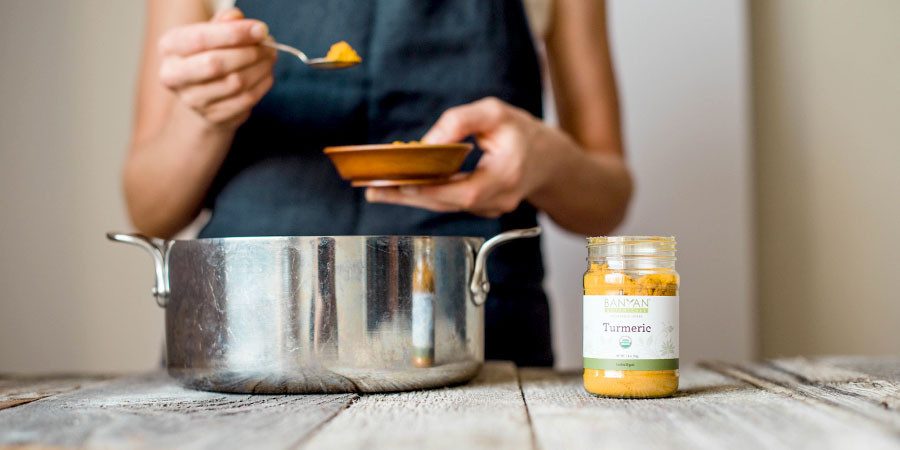
Cooking with Turmeric
Using turmeric as a kitchen spice is one of the most traditional ways to incorporate this beautiful herb into your life, and it has been used across the globe in all different types of cuisine. Cooking with turmeric is one of the most natural and gentle ways to enjoy its many benefits.
If you are new to cooking with turmeric, start slow. It burns easily when added directly to hot oil, and too much will give your food a dark golden color and a strong bitter taste. At the same time, have fun experimenting with this incredibly versatile herb!
Here are some tasty turmeric recipes to get you started:
Creamy Greens with Turmeric and Fenugreek
In addition to these recipes, try Banyan's Turmeric Milk and Kitchari Spice Mix. Both of these blends are utterly delicious—perfect for those who desire a simple and easy method of incorporating the health benefits of turmeric into their daily diet.
Is Turmeric Safe?
Turmeric is considered safe and effective when used appropriately. It is recommended to speak with your healthcare provider before taking turmeric if you are pregnant, nursing, or taking medications.
Contraindications
Turmeric is generally considered safe in pregnancy when used as a cooking spice in small amounts. However, we recommend consulting with your healthcare practitioner if you are pregnant or nursing.
Turmeric is best avoided in cases of acute hepatitis, jaundice, gallstones, bile duct obstruction, ulcers, and hyperacidity.26 Caution should be used when taking blood-thinning and platelet-inhibiting medications.27
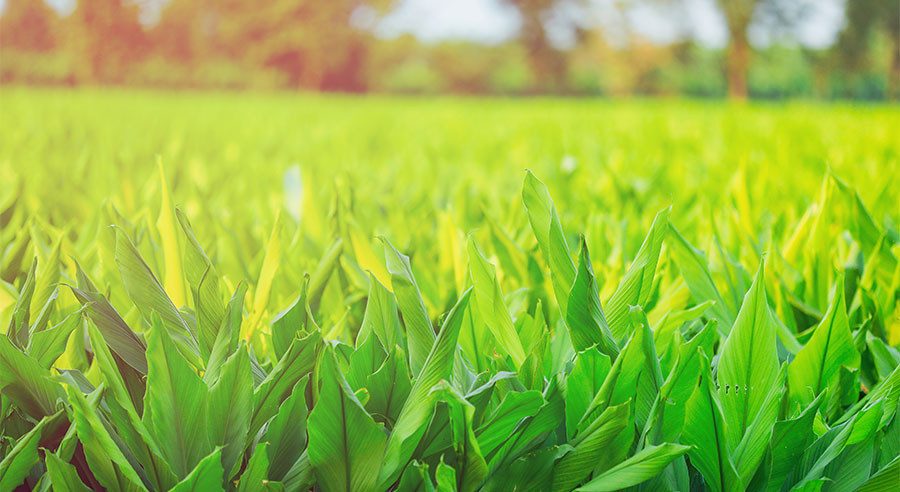
Growing and Harvesting Banyan's Turmeric
Banyan’s turmeric is grown by tribal farmers with small landholdings in the region of Andhra Pradesh, in India. Here, a network of small villages has been practicing communal, chemical-free farming for many generations.
These close-knit tribes of farmers exemplify the meaning of community, working together and taking turns in neighboring fields to help each other prepare, sow, tend, and harvest the crops.
The farmers sow the crops in April or May before the monsoon season begins, using carefully selected turmeric rhizomes from the previous year’s harvest. These crops are then watered with the natural seasonal rainfall and fertilized with manure from the farms. The rhizomes grow and multiply and are finally ready to harvest by the winter.
The turmeric harvest typically happens in January or February, with everyone working together and truckloads of rhizomes collected within a couple days. The mother rhizomes are preserved for the following year’s crops, and everything else is cleaned, peeled, and dried in the sun before being processed and ground into powder.
To learn more about our harvesting practice for the turmeric plant, watch our short video below, featuring Banyan co-founder and CEO, Kevin Casey.
Sustainability of Turmeric
Because our turmeric is cultivated, there are no issues with overharvesting or sustainability concerns.
As a part of a larger conversation regarding the sustainability of Ayurvedic herbs, it is important to understand where and how plants are grown and harvested.
We ensure sustainability by sourcing the botanicals used in our products from privately owned farms where each plant has been cultivated or harvested from legal wild-craft sourcing. Our herbs and ingredient-producing plants are harvested at optimal times, using environmentally sustainable practices sensitive to the long-term health of the plants.

